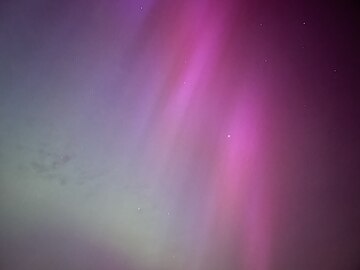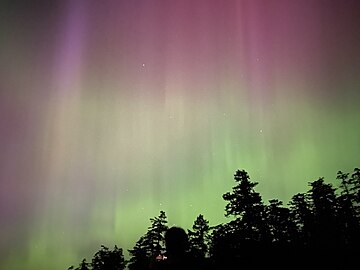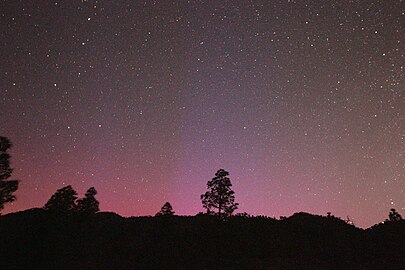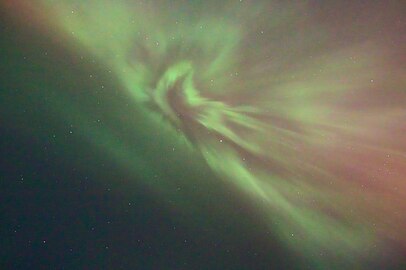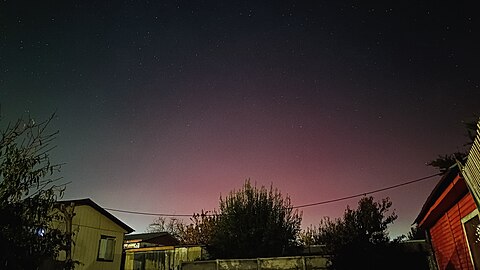May 2024 solar storms: Difference between revisions
→Comparison to other solar storms: removed contradictory content that contradicted the 2003 storm being stronger. |
RodRabelo7 (talk | contribs) Undid revision 1223570597 by Yash Soorma (talk) WP:MoS |
||
| Line 1: | Line 1: | ||
{{Short description|Ongoing solar event}} |
{{Short description|Ongoing solar event}} |
||
{{Current weather event|solar storm|date=May 2024}} |
{{Current weather event|solar storm|date=May 2024}} |
||
[[File:Aurora Australis From Melbourne.jpg|thumb|Aurora Australis as witnessed from Southern suburbs of Melbourne 38'''°''' S]] |
|||
{{Use dmy dates|date=May 2024}} |
{{Use dmy dates|date=May 2024}} |
||
Revision as of 02:53, 13 May 2024
This article is about a current solar storm where information can change quickly or be unreliable. The latest page updates may not reflect the most up-to-date information. Please refer to your local weather service or media outlets for the latest weather information pertaining to a specific location. |
 | |
| Date | May 10, 2024 |
|---|---|
| Type | Coronal mass ejection |
| Part of Solar cycle 25 | |
The solar storms of May 2024 are a series of powerful solar storms with intense to extreme solar flare and geomagnetic storm components that have been ongoing since 10 May 2024 during solar cycle 25. The geomagnetic storm was the most powerful to affect Earth since March 1989,[1] and produced aurorae at far lower latitudes than usual in both northern and southern hemispheres.[2]
Solar flares and coronal mass ejections

On 8 May 2024, a solar active region which had been assigned the NOAA region number 13664 (usually abbreviated as 3664) produced an X1.0-class and multiple M-class solar flares and launched several coronal mass ejections (CMEs) toward Earth.[3] On 9 May, the active region produced an X2.25- and X1.12-class flare each associated with a full-halo CME. On 10 May, the region produced an X3.98-class flare, and on 11 May at 01:23 UTC it produced another X-class flare of magnitude 5.4–5.7 with another asymmetrical full-halo CME.[4][5][6] The region also caused an S1 solar radiation storm with spikes reaching S2.[7]
Geomagnetic storm
Three CMEs from 8 May reached Earth on 10 May 2024, causing severe to extreme geomagnetic storms with bright and very long-lasting aurorae. Aurorae could be seen from the remote village of Hanle in northern India,[8] near the city of Urumqi in northwestern China,[9] and in Europe from as far south as Croatia[10] and southern Spain.[11] In North America, aurorae were seen as far south as Florida[12][13][14] and Mexico.[15][16] In the Southern Hemisphere, the aurora was seen in New Zealand,[17] Australia,[18] Chile, Argentina,[19] South Africa,[20] and as far north as Uruguay[21] and Namibia.[20]
Due to the interplanetary magnetic field reaching a magnitude of 73 nT (nanotesla) with the component along Earth's magnetic axis oriented strongly south, reaching as much as −50 nT, as well as due to moderately high solar wind density, and solar wind speed reaching 750–800 km/s (470–500 mi/s) between 11−12 May (UTC time), the event was classified as a G5-class geomagnetic storm (Kp=9), making it the most intense storm since the 2003 Halloween solar storms.[22][23] Several other CMEs were expected to reach Earth on 11 and 12 May.[24]
Comparison to other solar storms
This section needs additional citations for verification. (May 2024) |
The disturbance storm time index (Dst index) is a measure in the context of space weather. A negative Dst index means that Earth's magnetic field is weakened. This is particularly the case during solar storms. The 2003 Halloween solar storms had a peak Dst index of −422 nT,[25] while the March 1989 geomagnetic storm had a peak Dst index of −589 nT.[26] The May 1921 geomagnetic storm has been estimated to have had a Dst index of −907±132 nT. Estimates for the Carrington Event superstorm of 1859 are between −800 nT and −1750 nT.[27]
The May 2024 solar storms reached a maximum −412 nT[28] on May 11th, and by 00:00 UT on May 12, had receded to values above −100 nT, suggesting that the storms were over.
The Ap index of the May 11, 2024 storm has been registered at approximately 270, even more powerful than the March 1989 storm, which reached an Ap of 246.[citation needed]
Impact
The storm has been negatively affecting ground-based broadcasting and two-way radio communications on the HF, VHF and UHF bands due to preventing the ionosphere from forming and thus interfering with propagation.[29]
In Canada, power companies BC Hydro and Hydro-Québec stated that they had prepared for the storm, and monitored it as it impacted Earth on the 10th-11th. Unlike in 1989 where a previous solar storm caused a nine-hour long power outage in Québec, no outages were reported due to the storm's effects.[30][31]
In New Zealand, Transpower declared a grid emergency, and took some transmission lines out of service as a precaution against the storm.[32]
In the United States, telecommunications companies AT&T and T-Mobile stated that they were prepared to respond to disruptions in their networks, but it was predicted that significant impacts to cell service were unlikely because the networks rely on different frequencies than the HF bands affected by the solar storm.[33] While the National Oceanic and Atmospheric Administration (NOAA) reported that there were power grid irregularities and degradation in GPS and high-frequency radio communications,[34] both the Federal Emergency Management Agency (FEMA) and the United States Department of Energy reported no significant impacts to the population.[35]
Agricultural users of John Deere RTK GPS equipment reported significantly degraded positional accuracy during the geomagnetic storm. As the GPS receivers are used to guide tractors in precision agriculture, certain agricultural workers were forced to suspend planting activities entirely.[36][37]
Other impacts to satellite services include Starlink, whose users reported slower download speeds.[38][39]
Gallery
![]() Media related to May 2024 solar storms at Wikimedia Commons
Media related to May 2024 solar storms at Wikimedia Commons
-
Aurora as seen from Osage Beach, Missouri, U.S. (38°N)
-
Aurora as seen from Snoqualmie, Washington, U.S. (48°N)
-
Aurora as seen from Othello, Washington, U.S. (46°N)
-
Aurora Borealis as seen from Cwmbran, Wales (51°N)
-
Aurora as seen from Pawleys Island, South Carolina, U.S. (33°N)
-
Aurora as seen from East Sussex, UK (51°N)
-
Aurora as seen from Okeford Hill, Dorset, UK (50°N)
-
Aurora as seen from Bay View, Washington, U.S. (48°N)
-
Aurora as seen from Kraków, Poland (50°N)
-
Aurora as seen from Gran Canaria, Spain (28°N)
-
Aurora as seen from Vaihingen, Germany (49°N)
-
Aurora seen from Thornton-Cleveleys, UK (53°N)
-
Looking straight up into the aurora in Brastad, Sweden (58°N)
-
Looking straight up into the aurora in Onawa, Iowa, U.S. (42°N)
-
Aurora australis as seen from Quillón, Chile (36°S)
-
Aurora over Germany (51°N) in visible light
-
Aurora over Germany (51°N) in near infrared light
Note: Caption figures indicate geographic latitude, not magnetic latitude.
See also
References
- ^ Miller, Katrina; Penn, Ivan; Lindner, Emmett (11 May 2024). "Northern Lights Set to Return During Extreme Solar Storm's 2nd Night - Electrical utilities said they weathered earlier conditions as persistent geomagnetic storms were expected to cause another light show in evening skies". The New York Times. Archived from the original on 12 May 2024. Retrieved 12 May 2024.
- ^ Ralls, Eric (10 May 2024). "Auroras expected all weekend across the U.S. as massive solar storm hits Earth". Earth.com. Archived from the original on 11 May 2024. Retrieved 11 May 2024.
- ^ "Sunspot region 3664, major flares and CMEs!". SpaceWeatherLive. 8 May 2024. Archived from the original on 9 May 2024. Retrieved 11 May 2024.
- ^ "Sunspot region AR13664". SpaceWeatherLive. Archived from the original on 11 May 2024. Retrieved 11 May 2024.
- ^ "CME impact imminent, Two more earth-directed CMEs". SpaceWeatherLive. 10 May 2024. Archived from the original on 10 May 2024. Retrieved 11 May 2024.
- ^ "Yet Another X-class Flare!". Space Weather Prediction Center. National Oceanic and Atmospheric Administration. 11 May 2024. Archived from the original on 11 May 2024. Retrieved 11 May 2024.
- ^ "Solar Photons archive, 10 May 2024". Space Weather Live. 10 May 2024. Archived from the original on 12 May 2024. Retrieved 11 May 2024.
- ^ Sengupta, Trisha (11 May 2024). "Aurora illuminates sky in Ladakh's Hanle as extreme solar storm hits Earth: 'Extraordinarily beautiful'". Hindustan Times. Archived from the original on 11 May 2024. Retrieved 12 May 2024.
- ^ huaxia, ed. (11 May 2024). "View of northern lights in Urumqi". XinhuaNet. Xinhua. Archived from the original on 11 May 2024. Retrieved 12 May 2024.
- ^ Adams, Josh (10 May 2024). "Aurora Borealis Forecast for Friday Night as Large Geomagnetic Storm Rages, Causing Northern Lights to Shine". PA Weather Action. Archived from the original on 11 May 2024. Retrieved 11 May 2024.
- ^ Ortiz, Marina (11 May 2024). "La tormenta geomagnética más fuerte de los últimos 20 años provoca una gran aurora boreal visible en toda España" [The strongest geomagnetic storm of the past 20 years causes a great aurora borealis visible in all of Spain]. ABC Ciencia (in Spanish). Diario ABC, S.L. Archived from the original on 12 May 2024. Retrieved 12 May 2024.
- ^ Miller, Katrina; Jones, Judson (10 May 2024). "Solar Storm Intensifies, Filling Skies With Northern Lights". The New York Times. Archived from the original on 11 May 2024. Retrieved 11 May 2024.
- ^ Fritz, Angela; Hammond, Elise; Lau, Chris (10 May 2024). "Live updates: The latest on the massive solar storm". CNN. Archived from the original on 11 May 2024. Retrieved 11 May 2024.
- ^ "'Unbelievable!': Northern Lights seen in South Florida from 'severe' solar storm". NBC 6 South Florida. Associated Press. 11 May 2024. Archived from the original on 11 May 2024. Retrieved 11 May 2024.
- ^ Torres Vargas, César Eduardo (11 May 2024). "Estas son las mejores fotos de las auroras boreales en el norte de México" [These are the best photos of the northern lights in northern Mexico] (in Mexican Spanish). Infobae. Archived from the original on 11 May 2024. Retrieved 11 May 2024.
- ^ "Auroras boreales por primera vez en Yucatán" [Aurora borealis for the first time in Yucatán]. Tribuna Campeche [Campeche Tribune] (in Mexican Spanish). 11 May 2024. Archived from the original on 12 May 2024. Retrieved 12 May 2024.
- ^ "Incredible photos: Stunning aurora dazzles NZ skies". NZ Herald. 11 May 2024. Archived from the original on 11 May 2024. Retrieved 11 May 2024.
- ^ Shepherd, Tory; Paul, Kari (11 May 2024). "Spectacular southern lights seen across Australia after 'extreme' solar storm". The Guardian. ISSN 0261-3077. Archived from the original on 12 May 2024. Retrieved 11 May 2024.
- ^ "Aurora Austral impresiona en los cielos del sur de Chile" [Aurora Australis impresses in the skies of southern Chile] (in Spanish). MSN. 11 May 2024. Archived from the original on 12 May 2024. Retrieved 11 May 2024.
- ^ a b Iderawumi, Mustapha (11 May 2024). "Southern African Skies Light Up with Aurora as Historic Solar Storm Collides with Earth". Space in Africa. SANSA. Archived from the original on 12 May 2024. Retrieved 11 May 2024.
- ^ "Cielo rojo: el extraño fenómeno de la aurora austral que se pudo ver en Uruguay" [Red sky: the strange phenomenon of the aurora australis that could be seen in Uruguay]. Telenoche (in Spanish). 11 May 2024. Archived from the original on 11 May 2024. Retrieved 12 May 2024.
- ^ "Strongest geomagnetic storm since 2003, X5.8 solar flare". SpaceWeatherLive. 11 May 2024. Archived from the original on 11 May 2024. Retrieved 11 May 2024.
- ^ "Viewing archive of Saturday, 11 May 2024 Solar wind (Speed, Density), Interplanetary Magnetic Field (IMF) (Bt, Bz)". SpaceWeatherLive. Retrieved 13 May 2024.
- ^ "SWPC Issues Its First G4 Watch Since 2005". Space Weather Prediction Center. 9 May 2024. Archived from the original on 10 May 2024. Retrieved 11 May 2024.
- ^ "Strongest geomagnetic storm since 2003, X5.8 solar flare". SpaceWeatherLive. 11 May 2024. Archived from the original on 11 May 2024. Retrieved 12 May 2024.
- ^ Boteler, D. H. (10 October 2019). "A 21st Century View of the March 1989 Magnetic Storm". Space Weather. 17 (10): 1427–1441. Bibcode:2019SpWea..17.1427B. doi:10.1029/2019SW002278. ISSN 1542-7390. Archived from the original on 13 April 2024. Retrieved 12 May 2024.
- ^ "Near Miss: The Solar Superstorm of July 2012". NASA Science. Archived from the original on 11 May 2024. Retrieved 11 May 2024.
- ^ "Real-time Dst Index". World Data Center for Geomagnetism, Kyoto. Archived from the original on 10 May 2024. Retrieved 11 May 2024.
- ^ Ralls, Eric (11 May 2024). "'Extreme' and very rare G5-level solar storm hits Earth on Saturday". Earth.com. Archived from the original on 11 May 2024. Retrieved 11 May 2024.
- ^ "Major solar storm hits Canada, bringing risks and aurora, B.C. Hydro monitoring". Vancouver Sun. The Canadian Press. 10 May 2024. Archived from the original on 11 May 2024. Retrieved 12 May 2024.
- ^ "Solar storm spares province of any power outages, Hydro-Québec says". The Gazette. Montreal Gazette. La Presse Canadienne. 10 May 2024. Archived from the original on 12 May 2024. Retrieved 12 May 2024.
- ^ "Solar storm: Transpower extends grid emergency declaration". 1 News. Archived from the original on 12 May 2024. Retrieved 11 May 2024.
- ^ Sutton, Joe; Smart, Sara (10 May 2024). "AT&T and TMobile say they ready to respond to any impacts from geomagnetic storm". CNN. Archived from the original on 11 May 2024. Retrieved 12 May 2024.
- ^ "G5 Conditions Reached Yet Again!". Space Weather Prediction Center. Boulder, CO: National Oceanic and Atmospheric Administration. 11 May 2024. Archived from the original on 11 May 2024. Retrieved 12 May 2024.
- ^ Krisher, Tom; Funk, Josh; Dunn, Marcia (11 May 2024). "Solar storm puts on brilliant light show across the globe, but no serious problems reported". apnews.com. The Associated Press. Archived from the original on 12 May 2024. Retrieved 11 May 2024.
- ^ Koebler, Jason (12 May 2024). "Solar Storm Knocks Out Farmers' Tractor GPS Systems During Peak Planting Season". 404 Media. Archived from the original on 12 May 2024. Retrieved 12 May 2024.
- ^ Davis, Wes (12 May 2024). "Solar Storms are disrupting farmer GPS systems during critical planting time". The Verge. Archived from the original on 12 May 2024. Retrieved 13 May 2024.
- ^ Shetti, Utkarsh (11 May 2024). Williams, Alison; Mark, Potter (eds.). "Musk's Starlink satellites disrupted by major solar storm". Reuters. Retrieved 11 May 2024.
- ^ Musk, Elon [@elonmusk] (11 May 2024). "Major geomagnetic solar storm happening right now. Biggest in a long time. Starlink satellites are under a lot of pressure, but holding up so far" (Tweet). Retrieved 11 May 2024 – via Twitter.







